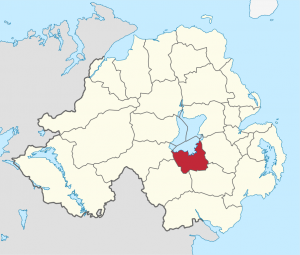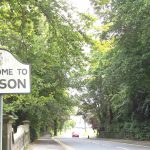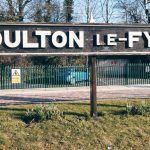Craigavon Made in the ’60s, named after a Viscount and built to last!
Welcome to the Five Minute Spare quick guide to Craigavon what was the first of Nothern Irelands “New Town” experiments in the 1960s, nestled neatly in between Lurgan & Portadown (which now along with Bleary form part of the Craigavon Greater Urban area) and bounded to the north by two artificial lakes. Anyway, what began as a vanity project named after the first Prime Minister of Northern Ireland, James Craig, 1st Viscount of Craigavon, in 1965 has since grown into a rather attractive and affluent town of 16,000 plus residents and an urban area which is home to over 65,000! So without further hesitation, join us as we take a 5-minute tour of Craigavon. There’s a whole ski slope just up the road… and that’s not even the half of it!

By TUBS – CC BY-SA 3.0
The Making of Craigavon
The Craigavon Development Commission was set up in 1965 to improve the 6,000 acres that lay between Portadown and Lurgan. The idea was that the two towns would be joined together one day, essentially becoming one giant city.
As the government did with the New Towns in Britain, they wanted this one to work as a sort of overspill catcher for the cities – in this case, it was Belfast. They hoped developers would start building there, taking some of the intensity of the population away from the city so they connected the area to the Irish M1 and hoped for the best.
Of course… nothing is ever that easy. The unionists and the republicans both fought over where it should be, what it should be, and what type of people it should contain. To this day, whole swathes of the land still aren’t developed because nobody could agree on anything. We don’t mean to judge, but this does still seem to be a bit of a recurring theme in Northern Ireland.
The Craigavon Metropolis
The outcome was that Craigavon ended up incorporating a number of villages and townland settlements, some of which are now districts of the town and their populations are included in the census as Craigavon. The “Craigavon Greater Urban Area” now comprises the above-named towns and the following:
- Aghacommon,
- Balteagh
- Clanrolla
- Corcreeny
- Crossmacahilly
- Drumgask
- Drumgor
- Drumnagoon
- Knockmenagh
- Legaghory
- Monbrief
- Moyraverty
- Tamnafiglassan
- Tannaghmore West
- And Tullygally.
With plenty of green fields between the main settlements!
One of the most notable things about the initial design of Craigavon is the way it was built. It was a linear town created so that roads and pedestrians didn’t necessarily go together. This safety-focused model is a little different and sometimes results in people getting frustrated. It also led to a complex path and roundabout system since there was less need for traffic signals to let people cross the roads. Another quirk of the layout of the buildings is their single-use zoning… so one area of the city was for residential, another for commercial and a third for industrial purposes.
Those who were born in the 80s and love video games now know that Craigavon in Northern Ireland was built exactly the same way as their city in SimCity II was. Whatever joining any groups of people together is never easy, however despite the problems the area is now rather upmarket and has been voted one of the best places to live in Nothern Ireland (in 2017).
Anyway, that’s enough about the laying out and piecing together of a new town to concentrate on the more fun aspects of Craigavon. It is chockfull of things to see, do and talk about. To that end, we looked up the most interesting facts we could… and all for you, you lucky things.
A Few Facts About Craigavon Urban Area
There are a ton of things you didn’t know about Craigavon. To be honest, we didn’t know them either and had to go look them up. Strap in, this is some (fairly) exciting stuff!
- Being established, designed and built-in 1965 is no problem for Craigavon, which has its very own historical society. Now we’re not saying it’s a front, but…
- Nearby Portadown was a settlement away back through time. The most important controlling clan here were the McCann’s. To this day, there are plenty of them in the area. The history of Portadown can be traced back to the Plantation of Ulster.
- The Craigavon Bridge is actually in Londonderry and spans the River Foyle which doesn’t even run through the County of Armagh.
- Portadown, Lurgan and Bleary are still largely regarded as towns within their own right… it is one of those situations where saying something is, and something actually being what it is, are a little different depending on perspective.
- Of the residents in Craigavon, around half identify as British. Of the remaining half, the split is down the middle between those that want to be Irish, and those that want to be Northern Irish.
- Craigavon is twinned with a town named LaGrange in Georgia, in the sunny south of the states. It is also twinned with Ballina in County Mayo.
- The Towns of Lurgan & Portadown are only separated from Craigavon by a few playing fields. That’s how close the development has gotten to making it a conurbation.
So there you go, it’s not only got some great sights to spot, it is also an interesting place in terms of facts.
Next, we wanted to split the history up between the regions of Portadown, Lurgan, and Bleary, to get a better grasp on what went on before we got here.
Portadown, Craigavon
As we mentioned above, Portadown was occupied by the clan McCann at the start of the 1600s. their association with the area actually goes back to the 13th century. It is said that the town takes its name from the old Irish for a port inside a small fort.
Just before the 1600s, the whole area was consumed by the nine years war against the English. In 1608, King James I eventually won out over the clans native to the island, took over, and sent people and soldiers to colonise his new territories. This story has been repeated all over the world where the British have set foot. You can’t just land in a place, claim it, then beat everyone up. In terms of land occupation, Middle-ages England was the playground bully.
The period immediately after the war was known as the Plantation of Ulster and saw a flood of Brits move to this area. The land subsequently changed hands between English nobles with tenuous Irish connections until the Obins family built a mansion where the Woodside Estate now stands. Obins went on to build the first bridge across the River Bann and led to the granting of a town charter. The charter allowed both a market and a fair.
In 1641, more than 100 British settlers were massacred in a rebellion. The town would later thrive as a textile centre throughout the industrial revolution, only to falter again in more recent years (and only in terms of wealth). If you would like a more detailed history we recommend Triposo for a reasonable take.
Bleary and Lurgan, Craigavon
Bleary didn’t make much of a stir in terms of history, at least not up until the times of the Troubles. People were killed in Bleary on both sides of the union debate, as well as on both sides of the religious debates. There is a full list of all incidents in Bleary from 1972 through to the 90’s over on Wikipedia. It’s fairly grim reading. Needless to say this area has settled down since then. It is an unfortunate situation at best.
Lurgan, on the other hand, has a bit more recorded history to draw from. It’s worth noting as well that much of history was written by the churches, so most of what we derive from the old days comes from religious records. Its name means ‘the long ridge’ which probably refers to the geology of the town site.
Lurgan has a similar history in some ways. It was ‘officially’ started in 1610 when James I, after conquering the area, granted lands to a man named John Brownlow. He went on to form a colony in the area, which would later become Lurgan. In the 17th century it was a known centre of textile production, not unlike Portadown. In 1699, in fact, a bunch of people from here moved out to America to the New World. They founded Lurgan in Pennsylvania, and so many native residents have long lost ancestry that live in America… a similar story throughout Ireland after the famine.
By 1836 the town had started to grow in industry and Lurgan Castle was first built. The Victorians also introduced the concept of public parks to stroll in, and Lurgan Park was built. It is Ireland’s largest one. The Poor Laws introduced around the same time meant that a workhouse was introduced in town. Conditions were terrible and it would have been a place that nobody wanted to end up.
The Famine
During the great famine, the town grew in residents, it more or less doubled from 2k to 4k. Why? The surrounding countryside was filled with starving farmers who flocked to the towns either to set sail for Britain or America or to gain work. Lurgan was one of the bigger industrial towns in the area which had a booming textile trade. Wool and cotton were cut and dyed here right up until the 1900s when the industry declined altogether. It helped stave off the worst of the starvation for the residents but alas, it led to some fairly unsanitary working and living conditions.
As a result of the swelling in population, there was starvation in the workhouses. A relief committee was set up by the local nobles and Dublin contributed to help. The money provided soup kitchens with food and essentially kept people alive. It is estimated that around 2,900 people died in Lurgan during the famine… that’s some amount of starvation even in a town that still managed to grow. We can only hope that the mistakes of the past are never repeated.
Lurgan found itself at a bit of a loose end after the 1900s. There was little industry and two wars had seen fewer and fewer young men around. The new city of Craigavon brought some much needed industry back into the area, and even attracted other opportunities for work. Since its building, the town of Lurgan has gone from strength to strength, forming an important part of a much larger community.
Last of all for the history of this important area is mention of the Troubles. When the fighting was finished, Lurgan had earned its name as part of the ‘murder triangle’ thanks to the issues in Bleary and Portadown. This is not a reputation any city wants to cling to, and we can only sympathise.
Between the three places, the Craigavon greater area is formed on the edge of history. Let’s hope that, going forward, we don’t repeat the mistakes of the past… and not just in this area, but throughout the British Isles. If we could just stop invading places? We would settle for that…
Famous People from Craigavon
Now that we got all the pesky history out of the way, let’s talk famous faces. There isn’t a single town in Northern Island that doesn’t have at least one famous singer in it… let’s see what Craigavon holds in musical delights…
- Neil Lennon, a former Premier League footballer, Celtic player, and football coach, is Lurgan born.
- The Harrison Brothers, four professional cricketers in one family, come from Lurgan.
- The famous TV presenter Gloria Hunniford is from Portadown.
- Aaron McCusker – the actor who played ‘Jamie’ in Shameless, is Craigavon born.
- Internationally celebrated poet Sinead Morrissey is also a resident here.
As it stands, we are simply waiting for the next big boy/girl group to come out of the area… Other than that, Craigavon has its fingers in many famous pies, so to speak. Although we are really not sure if we like that analogy. Let’s move swiftly on and not think about it too closely.
Attractions
Now that we know all about Craigavon, let’s find out what things you can see and do there.
Historic Sights and Landmarks
There is a historic burial ground in Lurgan that you might want to visit. It is a Quaker burial ground at Lynastown. The Quakers were established in 1650 and are a Christian group that reject sacraments, rituals, and any formal religious ceremonies (which could be construed as witchcraft).
You can check out the Gilford Community Centre and the Gilford War Memorial too if you are into your historical attractions. We would suggest that you stop at Gilford Castle to take some Instagram pics while you are there. This Victorian-era Scots Baronial style castle was built in 1865 and sports 200+ acres of stunning natural grounds. It’s the perfect place to explore on a warm day.
Museums and Galleries
If you want to learn more about the local history, trace your ancestry, or anything else history related, the Brownlow library can help you. There aren’t many museums in the area, but the Historical Society does note the presence of museum services under the jurisdiction of County Armagh.
There are a few options for galleries as the Northern Irish are a cultured bunch. The FE McWilliam Gallery and Studio sports local work and is well worth a visit. You can also pop into art gallery 454 to pick up some contemporary masterpieces of your very own. The choice is entirely yours.
Shopping and Retail
Visit the Omniplex cinema in Craigavon for something to do with kids. Or go shopping at the Rushmere Shopping Centre. It’s got both a B & M and a Home Bargains. You don’t get much better than that.
Sports
There is a team formed in Craigavon and many sportsmen and women have come from it over the years. In 1978 the Association Football Club of Craigavon was formed, and they can be found playing at Lakeview Park. You can book game tickets and, if you are a good sweet-talker, you may be able to book a tour of the grounds.
As far as rugby is concerned, there is a team but it belongs to Lurgan specifically. The Lurgan Rugby Club has recently won the Gordon West Cup for the third time – the first team ever to hold it for more than two wins.
Again, there are a couple of places in Craigavon that you can play golf. The Irish love this strangely slow-paced game almost as much as the Scots, so you can often find a golf club within striking distance of any given town. In Craigavon you can visit the Silverwood Golf Club, or you can play at the Lurgan Golf Club for a day on a pass. You can also pick up equipment and gear at the Tandragee Professional golf shop if you want to buy a set of clubs to get started with, new balls, or if you need some lessons.
Outdoor and Recreation
Since Craigavon covers the southern edge of Lough Neagh, you can enjoy the sights and sounds found out at Oxford Island. They have a visitors’ centre that gives you maps and explains the wildlife of the local area – which happens to be a nature reserve. The whole place is spectacular and well worth the trip. On top of this, you can visit the Lough Neagh discovery centre to learn all about the loch, what lives in it, and what you can find growing around it.
Other Things to do in Craigavon
The whole area has so much going for it that we couldn’t possibly list it all in one place. Some of the other sights we recommend you visit if you are in the area for any length of time include:
- The RSPB Lough Neagh Portmore Nature Reserve – this is another nature reserve on the banks of the lake. We thought three was probably two too many.
- There is a Bedlam Paintball centre in Portadown that teenagers will love.
- And a gaming arena called the Craigavon Kestrels that is something to do with computers…
No matter what your interests are, you will always find something to do in or around Craigavon!
How to get there?
Now all we need to know is how to get to this lovely place. Don’t go scrolling off just yet, we’ve got you covered.
By Road
They literally built Craigavon right in the path of the M1, on purpose, to make it a good overspill city for Belfast. Head north out of town and you can’t miss it.
By Rail
You have your choice between Lurgan station and Portadown station, the latter has a park and ride service and was recently opened in order to aid commuters out of Belfast.
By Air
Belfast International Airport is not far from Craigavon, remember to book travel arrangements at the other side.
By Sea
You can get to Portadown if you can sail the River Bann. It is not really accessible by sea yacht though, should you be lucky enough to own one!
Got Five Minutes?
That’s about all we have for this edition of Five Minutes Spare’s many travel itineraries. We hope that we have managed to entertain you for a little while, even if you never make it as far as Craigavon. Don’t forget you can stop by our site for any other amusements. Want to learn a new skill? Need to educate yourself on other matters? You can do it all if you take that five minutes and invest it wisely.


